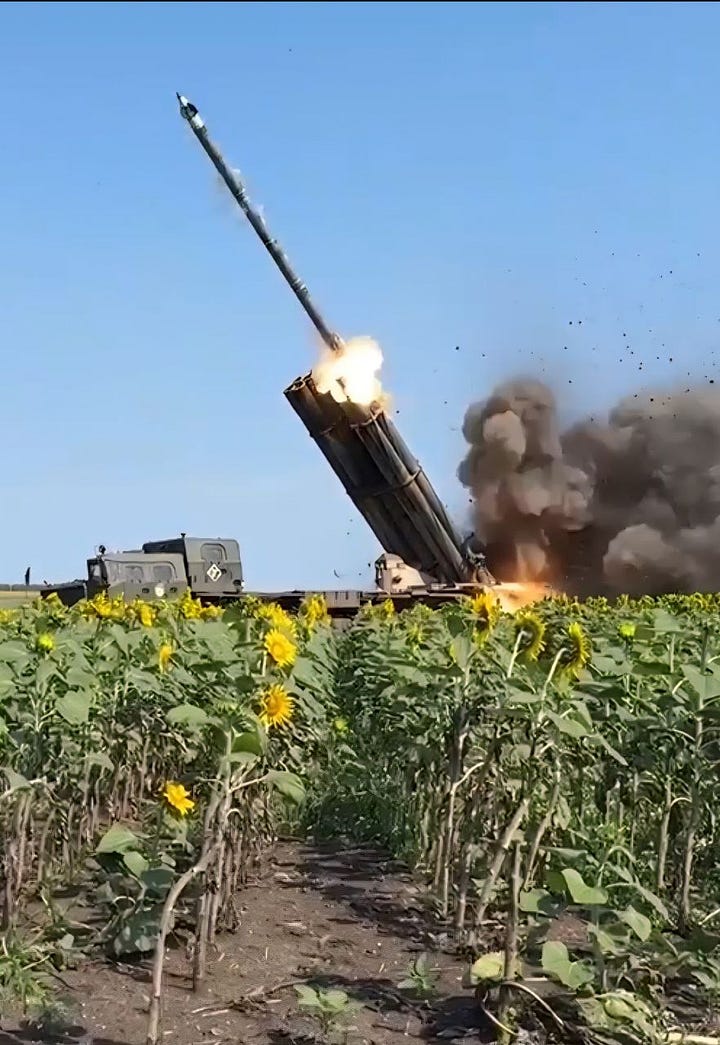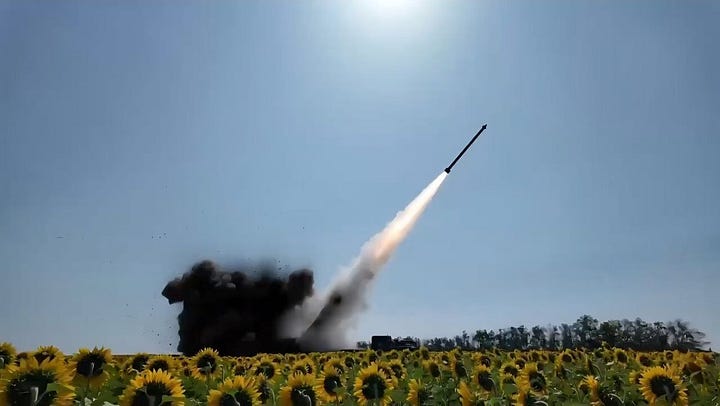Images Draw Attention To Russian Employed Of Guided 300 mm Diameter Artillery Rockets, Highlight Limited Availability
🇷🇺 🇺🇦
Note: The following text was originally posted on my X/Twitter account.
Recently released images show the use of guided 300 mm diameter heavy artillery rockets—missiles by another name—with Russia’s wheeled 9K515 Tornado-S system, which amounts to a larger counterpart to the wheeled American HIMARS launcher and a wheeled counterpart to the tracked American M270 MLRS launcher. The Tornado-S is understood to be capable of launching 300 mm diameter missiles that have a maximum range of 120 kilometers. The Tornado-S, which is the intended successor to the longstanding Soviet 300 mm diameter BM-30 Smerch system, can be used to launch several different missiles, including missiles that are used to dispense submunitions.
While there have been unambiguous indications that the Tornado-S has been used to launch guided 300 mm diameter missiles since February 2022, publicly available information suggests that these are not widely or regularly employed despite being highly suitable for use in the context of the Russia-Ukraine War. Ukraine’s extensive mileage from its regular and widespread use of smaller, lighter, and shorter-range American-built 227 mm diameter guided artillery rockets/missiles launched from the HIMARS and M270 launchers offers a stark contrast to the Russian experience with the Tornado-S and similar, as does Ukraine’s more limited employment of much larger, heavier, and longer-range 610 mm diameter American-built ATACMS short-range ballistic missiles.




The Russian Army has paid an immense price for the apparent unavailability of the Tornado-S or something similar across the vast, actively contested frontage of the Russia-Ukraine War. For the most part, the Russian Army has been simply unable to attack many potential targets located more than 30-40 kilometers from the frontline and has been forced to regularly turn to the much larger, heavier, and longer-range—and much more expensive—920 mm diameter 9K720 Iskander short-range ballistic missiles to attack targets of opportunity locataed within 100 or so kilometers of the frontline. Such targets are located too far from the frontline to be practically attacked with guided glide bombs (which were not available for use by the Russian Air Force in February 2022 and only became widely available in increasing numbers from the autumn of 2023), armed “FPV” multirotor drones (which only became available from late 2023 onward), and so forth. It is important to note that the 9K720 Iskander ballistic missile is in a wholly different capability class than even the longest-range versions of the American ATACMS ballistic missile, for which there was and remains no direct Russian analogue.
One of the many underappreciated aspects of the Russia-Ukraine War concerns how the Russian Army went to war with a capability set that was not appropriate for its preferred approach to land warfare in light of existing battlefield conditions. The Soviet Army developed and deployed an extensive and elaborate set of short-range strike capabilities—some of which were intended to deliver so-called “tactical” nuclear weapons against battlefield targets—in support of its maneuver units. The now-defunct Intermediate-Range Nuclear Forces (INF) Treaty and the dissolution of the Soviet Union left the Russian Army poorly positioned to adapt to the evolving realities of land warfare, many of which were, of course, on public display in the Gulf War (1991) before the Soviet Union was formally dissolved. The three decades or so of technological change preceding Russia’s full-scale invasion of Ukraine in February 2022 did not make the battlefield any more hospitable, and the Russian Army was very slow to adapt and, more importantly, adapt at a scale commensurate with its expansive force structure and the unrealistic military objectives set by its military leaders and their political masters in Moscow.
Until the 2010s, the Russian Army’s maneuver units were amply supported by large numbers of 650 mm diameter OTR-21 Tochka short-range ballistic missiles and associated launchers, as well as a vast number of smaller diameter unguided artillery rockets, to say nothing of tube artillery more generally. The fairly large diameter of Tochka missiles notwithstanding, these were fairly short-range systems—the longest-range Tochka version to enter service has a maximum range of just 120 kilometers, which makes it broadly comparable to the newer 300 mm guided artillery rockets used with the Tornado-S. While the Tochka remained useful for the Russian Army, it was, however, an outdated design, and a replacement was in order.
Faced with limited resources and competing requirements, the Russian Army decided not to pursue a like-for-like replacement of the Tochka or even pursue something larger and more sophisticated like the American ATACMS, but to replace the Tochka with the Iskander ballistic missile, which occupies a wholly different capability class. Simply stated, the Iskander is not optimized for use in supporting maneuver units in the manner of the Tochka and is best used in interdiction-type strikes against targets situated much further away from the frontline. In principle, the Russian Army could have employed Iskander ballistic missiles against much more proximate targets in the Russia-Ukraine War in support of Russian maneuver units, but Russia has never had a large enough stockpile of ready-to-use Iskander ballistic missiles for use in this manner. As the Russia-Ukraine War extended in duration, Iskander ballistic missiles have been primarily used in so-called deep strikes against primarily stationary targets located several hundred kilometers from the frontline, as well as occasional strikes against fleeting targets of opportunity, including those located within 100 or so kilometers from the frontline.
While Russia reactivated some number of Tochka launchers prior to February 2022 and thereafter launched large numbers of stockpiled Tochka missiles held in reserve against Ukraine, the Russian Army essentially went to war without much in the way of long-range fire support in the absence of the widespread deployment of large numbers of Tornado-S launchers and associated 300 mm diameter guided artillery rockets/missiles or similar. It is important to recognize that the Russian Air Force was neither designed nor prepared to provide meaningful fire support to Russian maneuver units with its large fleet of fixed-wing combat aircraft in either close air support or interdiction-type missions. As a result, the Russian Army was forced to provide such fire support to its maneuver units and the Tornado-S—and broadly similar guided artillery rockets of various sizes and capability classes—were and remain very well suited for such a role.
Unlike the Iskander ballistic missile, Russia’s land-attack cruise missiles, and Russia’s longest-range propeller-driven strike drones—the Shahed-136/Geran-2/Garpiya—the Tornado-S and Russia’s 300 mm diameter guided artillery rockets/missiles have received strikingly little attention over the course of the war. This includes discussions of Russia’s production output of 300 mm diameter guided artillery rockets/missiles despite the inherent potential for such munitions to help change Russia’s fortunes in this gruelling attritional conflict. Ukraine’s extensive employment of American-built 227 mm diameter guided artillery rockets/missiles and 610 mm diameter short-range ballistic missiles from wheeled HIMARS and tracked M270 MLRS launchers is a case in point.
Going forward, the Russian Army faces strong incentives to deploy the Tornado-S and/or similar guided artillery rockets/missiles in large numbers. It is possible, even likely, that existing Iskander ballistic missile launchers will be made directly subordinate to Russia’s five military districts, while the corps-sized “armies”—such as the 1st Guards Tank Army, which is subordinate to the Moscow Military District—will receive Tornado-S launchers and perhaps a short-range ballistic missiles comparable to the American ATACMS that is far more suitabe for use against battlefield targets and which will be a true successor to the Tochka in the manner that the Iskander never could. The reported development of an extended-range version of the Iskander and Russia’s development and deployment of the much longer-range Oreshnik ballistic missile are driving the Russian Army’s missile brigades to new roles far removed from the primary role of these units when equipped with Tochka ballistic missiles, which was to provide (contextually) long-range fire support to maneuver units. The Tornado-S may, as such, eventually become a key part of the Russian Army’s strike capabilities, but even as it appears to have played a strikingly limited role in the Russia-Ukraine War as of this writing.

